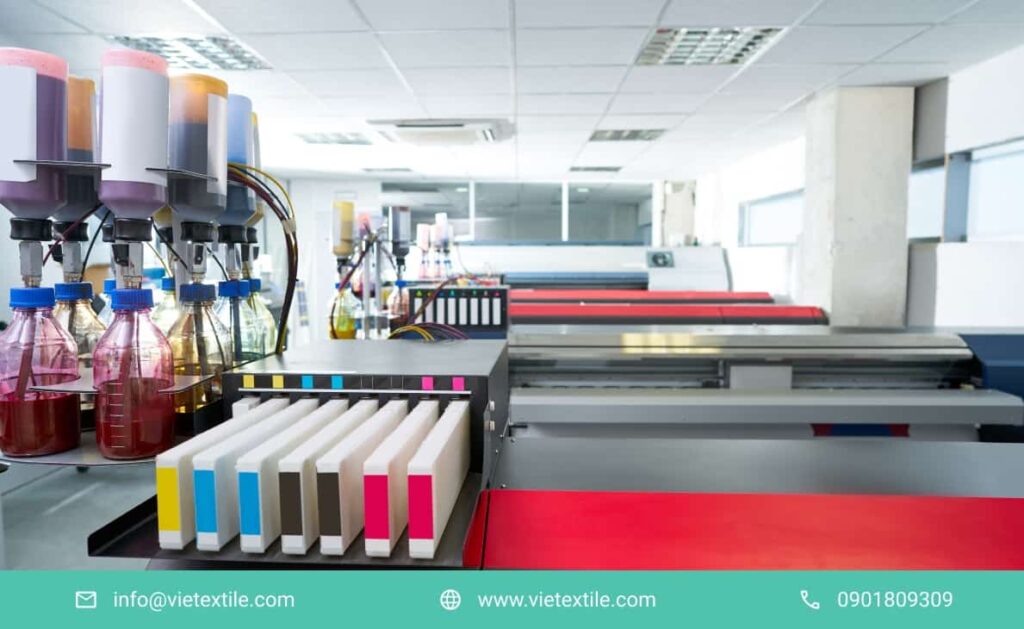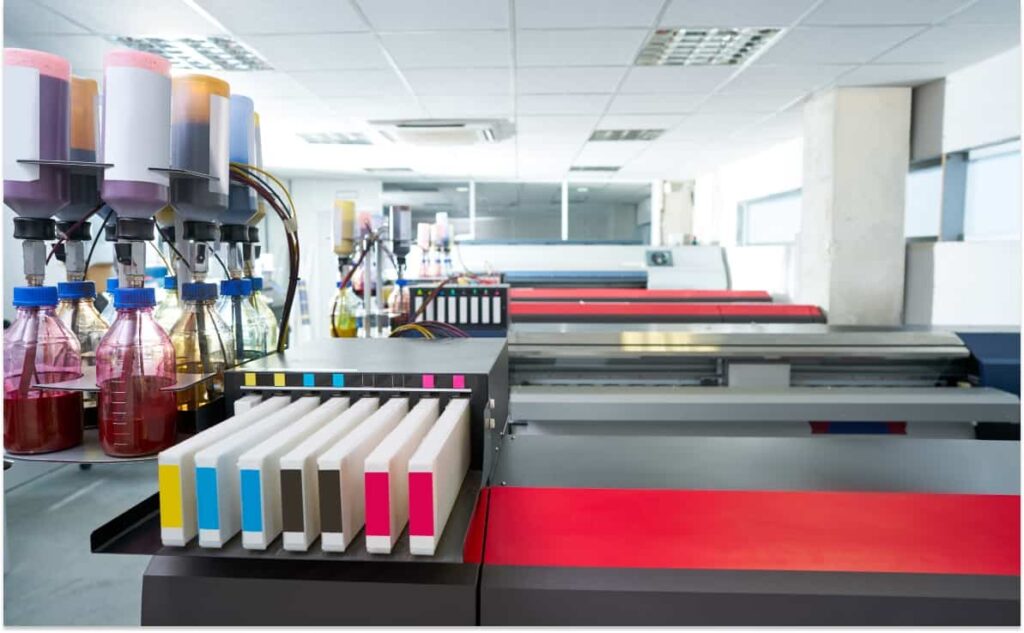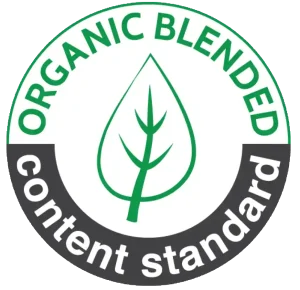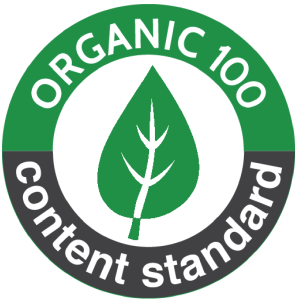Digital printing on 100% cotton fabric has always been a technical challenge, especially when the goal is to achieve brilliant colors and high durability. However, by using specialized Direct-to-Fabric Cotton Ink (Reactive type), manufacturers can easily overcome this barrier. This article by VieTextile will delve into the tips and technical processes to ensure your prints always stand out and achieve the best quality.
This extended introduction sets the context and objective of the article. Digital printing on textiles is transforming the global garment industry, and mastering Direct-to-Fabric Cotton Ink (Reactive) is key to creating products with high aesthetic value that meet the stringent requirements of the modern fashion market. We will explore the working mechanism of this ink, fabric preparation steps, optimization of the printing process, and post-treatment to maximize color saturation.

1. What is Reactive Direct-to-Fabric Cotton Ink?
Nội dung tóm tắt
ToggleReactive Direct-to-Fabric Cotton Ink (active ink) is a specialized ink designed to create a direct chemical bond with cellulose fibers, typically 100% cotton and other natural woven fabrics. This is why they are considered the optimal choice for printing on high-end textile products that require superior sharpness and color fastness. The use of this type of Direct-to-Fabric Cotton Ink provides outstanding printing efficiency in terms of both quality and aesthetics.
The following paragraphs will delve deeper into the working mechanism of this Direct-to-Fabric Cotton Ink, clarifying its difference from other common inks like Pigment or Acid inks. The chemical bonding mechanism is the crucial factor that allows the ink to penetrate deep and become part of the fiber. This process ensures that even after multiple washes, the product’s colors maintain their freshness and do not fade. This is the outstanding advantage of Reactive Direct-to-Fabric Cotton Ink.
1.1. Working Mechanism of Reactive Ink on Cotton
The working mechanism of Reactive Direct-to-Fabric Cotton Ink is based on a chemical reaction between the Chromophore group (color carrier) in the ink and the hydroxyl group (OH) in the cellulose fiber of cotton. This reaction is activated by steam (steaming) and an alkaline environment (pre-treatment chemicals). This process completely sets it apart from inks that merely adhere to the surface.
The reaction creates an extremely durable covalent bond. This bond is almost impossible to break by common physical or chemical actions such as washing with soap or sun exposure. Thanks to this mechanism, Reactive Direct-to-Fabric Cotton Ink provides the highest color fastness among all current digital printing techniques.
The basic components of Reactive Direct-to-Fabric Cotton Ink include colorant, carrier (water and glycol), viscosity modifier, and surface tension regulator. Controlling viscosity is crucial for the ink to be precisely jetted through the print head without clogging.
Reactive Direct-to-Fabric Cotton Ink is often divided into different chemical groups such as Vinyl Sulfone (VS) or Monochloro-triazinyl (MCT). Each group has different reaction speeds and bonding characteristics, requiring fine adjustment in the pre-treatment and steaming process.
The printing process using Reactive Direct-to-Fabric Cotton Ink requires high temperatures for hydrolysis to occur, followed by the bonding reaction. If the steaming temperature is insufficient, only a small portion of the ink reacts, leading to the need to wash off a large amount of excess ink.
The functional groups of the alkaline chemicals in the pre-treatment solution act as catalysts, creating the necessary high pH environment. Without alkali, the reaction between the Direct-to-Fabric Cotton Ink and the cotton fiber will not occur or will be very weak.
1.2. Comparison with Other Inks for Cotton Fabric
When comparing Reactive Direct-to-Fabric Cotton Ink with Pigment ink, the biggest difference lies in the hand feel and color vibrancy. Pigment ink adheres to the fabric surface using a binder, creating a thicker and stiffer feel, especially when printing large solid areas.
Conversely, Reactive Direct-to-Fabric Cotton Ink fully penetrates the fiber and does not require a binder. This preserves the natural softness, drape, and breathability of the cotton. This is a decisive factor when producing high-end garments that demand maximum comfort.
Acid and Disperse inks are other types of inks, but they are not used for cotton. Acid ink is for protein fabrics (wool, silk) and Disperse ink is for synthetic fabrics (Polyester). Therefore, Reactive Direct-to-Fabric Cotton Ink is the optimal solution for 100% cotton in terms of technology, achieving both color and durability.
The superior benefits of Reactive Direct-to-Fabric Cotton Ink explain why high-end fashion brands always prioritize its use for their collections, where quality and color fastness are the top criteria. The wash fastness of Reactive can reach level 4-5, significantly higher than Pigment ink.
Investing in the printing process with Reactive Direct-to-Fabric Cotton Ink has a higher initial cost. However, in the long run, the quality of the final product and customer satisfaction bring sustainable competitive advantages to the business.
2. Fabric Preparation: The Foundational Secret for Vibrant Direct-to-Fabric Cotton Ink
To ensure the colors from Reactive Direct-to-Fabric Cotton Ink achieve maximum vibrancy, fabric preparation is an indispensable step, accounting for up to 50% of the print’s success. 100% cotton fabric needs thorough pre-treatment to create the ideal chemical environment for the reaction.
Pre-treatment helps the fabric absorb ink more evenly, prevents bleeding, and enhances the ink’s adhesion to the fiber surface. A high-quality pre-treatment solution will contain the necessary auxiliary chemicals so that the Direct-to-Fabric Cotton Ink can react effectively. This process is the foundation for color vibrancy.
2.1. Standard Pre-treatment Process
100% cotton fabric needs to go through steps like cleaning, bleaching (if necessary), and most importantly, padding with the pre-treatment solution. This solution includes alkali agents like Sodium Bicarbonate, humectants like Urea, and thickeners like Sodium Alginate to create reaction conditions for the Direct-to-Fabric Cotton Ink.
The padding process must be performed using a Padder machine to ensure the amount of solution (Pick-up) absorbed by the fabric is uniform and accurate. The ideal pick-up ratio typically ranges from 60% to 80%, depending on the fabric type and thickness. This uniformity is key to preventing color differences on the same roll of fabric.
Sodium Bicarbonate or similar alkalis maintain a high pH environment (around 10.5 – 12.0) on the fabric. This alkaline environment directly catalyzes the covalent bonding reaction between the Direct-to-Fabric Cotton Ink and cellulose, determining the final color fastness.
Urea acts as a humectant, keeping the Direct-to-Fabric Cotton Ink in a liquid state during the initial drying and steaming process. This gives the ink enough time to diffuse into the fibers and react completely, maximizing color saturation.
Sodium Alginate is a natural thickener that helps control ink spread on the fabric and maintains sharp print lines, especially important when printing complex geometric patterns. Controlling the concentration of Alginate directly affects the quality of the Direct-to-Fabric Cotton Ink upon contact with the fabric.
The control of Padder machine parameters, including roller pressure and fabric running speed, must be closely recorded and monitored. Any change in pressure can alter the Pick-up ratio, leading to non-uniform vibrancy of the Direct-to-Fabric Cotton Ink after printing.
2.2. Role of Humidity and Temperature After Treatment
After padding with the pre-treatment solution, the fabric needs to be dried properly. However, it should not be dried completely. A residual moisture content of about 5% – 8% is necessary for the Reactive Direct-to-Fabric Cotton Ink to dissolve and react optimally in the subsequent steaming stage.
Ensure the drying temperature is appropriate (usually below 120°C) to avoid damaging the pre-treatment chemicals absorbed by the fabric. Too high a temperature can cause the alkalis and Urea to decompose or crystallize prematurely, significantly reducing the reaction efficiency of the Direct-to-Fabric Cotton Ink.
Moisture control is achieved using specialized moisture meters integrated into the dryer. This is a precise measuring tool to ensure the fabric reaches ideal conditions before being fed into the Direct-to-Fabric Cotton Ink inkjet printer.
Controlling humidity and temperature is a critical technique that determines the depth and vibrancy of colors when printing with Direct-to-Fabric Cotton Ink. Small deviations can lead to “ringing” or “halo” around the printed details.
For knitted cotton fabric, controlling shrinkage after drying is crucial to ensure accurate color registration during printing. The fabric must be processed, stretched, and dried stably for the Direct-to-Fabric Cotton Ink inkjet printer to operate effectively.
3. Optimizing the Digital Printing Process with Direct-to-Fabric Cotton Ink

The digital printing process with Direct-to-Fabric Cotton Ink must be strictly controlled from design to machine printing. Optimizing printing parameters is the most important tip to ensure that the color transitions accurately and vibrantly from screen to fabric.
Using an accurate Color Profile (ICC Profile) is mandatory. This profile helps the printer understand how to convert RGB or CMYK color values from the design file into the actual amount of Direct-to-Fabric Cotton Ink jetted out by the print head.
3.1. Calibrating the ICC Profile for Vibrant Colors
The ICC Profile is the “color brain” of the printing process. For Reactive Direct-to-Fabric Cotton Ink, profile calibration needs to account for the absorption and reaction of 100% cotton in an alkaline environment. A properly created profile will maximize the color gamut.
The profiling process begins by printing a test chart using the Direct-to-Fabric Cotton Ink that has been steamed and washed. This chart is then measured with a Spectrophotometer to collect Lab* color data.
This Lab* data is used by the RIP (Raster Image Processor) software to create a color transformation matrix, ensuring that the red on the screen prints out an equivalent red on the fabric. This calibration is the key step to fully utilizing the color range of the Direct-to-Fabric Cotton Ink.
Use a spectrophotometer to measure and create custom profiles for each specific type of cotton fabric you use (e.g., Cotton Poplin, Cotton Jersey). This ensures that difficult colors like bright red, neon blue, or deep black still achieve the highest saturation when using Direct-to-Fabric Cotton Ink.
A good profile will also help control “D-Max” (Maximum Density) – the maximum depth of black color. Achieving a deep black (Neutral Black) is a challenge that requires a precise balance between the CMYK colors of the Direct-to-Fabric Cotton Ink.
Regular checking and calibration of the profile are necessary due to changes over time in the print head, new batches of Direct-to-Fabric Cotton Ink, or changes in printing environment conditions such as workshop temperature and humidity.
3.2. Accurate Ink Limits Adjustment
The amount of Direct-to-Fabric Cotton Ink jetted out (Ink Limits) must be carefully adjusted. If too little ink is used, the color will be pale and lack depth. If too much ink is used, the fabric can become saturated, leading to bleeding or loss of detail when printing small elements.
Experienced print engineers often determine the Maximum Ink Coverage by test-printing gradient samples and inspecting them under a magnifying glass. Fine-tuning the ink volume is a crucial tip that helps save costs while enhancing color vibrancy.
RIP software controls the amount of Direct-to-Fabric Cotton Ink by adjusting parameters such as Total Ink Limit (maximum total ink volume) and Black Ink Generation (how black is generated). This balance affects both printing speed and color quality.
Ink Limits adjustment must also consider the printing resolution (DPI). Printing at high resolution (e.g., 1200 x 1200 DPI) usually requires less ink than printing at low resolution to prevent the fabric from becoming overly saturated.
In addition, the performance of the print head is also a factor. Different types of print heads (Kyocera, Epson, Fuji) have different droplet sizes. The droplet size must be calculated to ensure the Direct-to-Fabric Cotton Ink is distributed optimally on the fabric surface.
Sometimes, adjusting the print head voltage is necessary to ensure the Direct-to-Fabric Cotton Ink is ejected at a uniform velocity, especially when the ink’s viscosity changes slightly due to ambient temperature variations.
4. Steaming and Washing Treatment: Finalizing Reactive Cotton Ink Quality
After printing with Reactive Cotton Ink, the final two steps—Steaming and Washing—are decisive for color fastness and brightness. If this process is skipped or performed incorrectly, the print will fade quickly.
Steaming is the process of providing high temperature and humidity (usually 102°C – 105°C) to activate the chemical reaction of the Reactive Cotton Ink with the cotton fiber. This process helps create a permanent durable bond between the ink and the fabric.
4.1. Optimizing Steaming Time and Temperature
The standard steaming time for Reactive Cotton Ink usually ranges from 7 to 10 minutes, depending on the type of steamer (mini steamer or continuous steamer) and the fabric thickness. Thicker fabrics require longer steaming time to ensure steam penetrates deep into the fiber core.
Ensure the steam in the chamber is saturated (100% humidity) and free of oxygen. Oxygen can oxidize the Reactive dyes before they have a chance to react with the fiber, leading to dull or faded colors.
Proper steaming will “lock in” the color, helping the Reactive Cotton Ink resist fading later. Temperatures below 102°C will slow the reaction rate, while too high a temperature can damage the fabric and the ink.
During operation, the steam pressure and circulation inside the chamber need to be monitored. Uneven steam distribution can lead to differences in color saturation between parts of the fabric roll printed with Reactive Cotton Ink.
The necessary amount of steam must also be adjusted so that the fabric maintains humidity throughout the steaming process, preventing it from drying out and interrupting the chemical reaction of the Reactive Cotton Ink with cellulose.
4.2. Post-Print Washing to Remove Excess Chemicals
The goal of post-print washing is to completely remove all unreacted Reactive Cotton Ink and pre-treatment chemicals. If not fully removed, these chemicals will continue to react slowly or cause fading and yellowing over time.
The washing process requires specialized Surfactants and warm water (usually 60°C – 80°C). Hot water helps dissolve and remove the unbonded Reactive Cotton Ink molecules.
The washing process includes several stages: cold water pre-wash, hot soap wash to remove Reactive Cotton Ink and chemicals, followed by rinsing to completely remove surfactants.
Using Sequestering Agents during washing is very important. Metal ions in the water can react with Reactive ink, reducing color brightness, so the quality of the incoming water must be controlled.
Thorough washing not only increases color fastness but also restores the original softness of the 100% cotton fabric. If the washing process is not effective enough, the fabric will retain a stiff and dry feel due to residual pre-treatment chemicals.
Controlling the pH of the final rinse water (usually neutral pH, 6.5 – 7.5) ensures that no residual alkali or acid remains that could harm the fabric or the end user’s skin on products printed with Reactive Cotton Ink.
4.3. Color Fastness Test Standards for Reactive Cotton Ink
To ensure printing quality with Reactive Cotton Ink meets export standards, color fastness testing is the final and mandatory step in the textile production process. These standards are regulated by international organizations such as ISO and AATCC.
Wash Fastness: Checks the print’s ability to retain color when washed at various temperatures and chemical conditions. Standards like ISO 105-C06 or AATCC 61 are commonly applied to products using Reactive Cotton Ink.
Rubbing Fastness: Checks resistance to color transfer when rubbed, both dry and wet. ISO 105-X12 standard is necessary to evaluate the printing quality and the adhesion ability of the Reactive Cotton Ink on the fiber surface.
Light Fastness: Assesses the resistance to fading upon exposure to sunlight or artificial light. Reactive ink generally has better light fastness than Acid ink, tested according to ISO 105-B02 standard.
These standards not only help ensure the quality of products printed with Reactive Cotton Ink but also serve as proof of compliance with environmental and chemical safety regulations. Achieving high scores in these tests is a major competitive advantage.
5. VieTextile: Your Partner for High-Quality Reactive Cotton Ink

VieTextile is proud to be a strategic partner in the digital textile printing industry, specializing in providing comprehensive solutions including premium Reactive Cotton Ink. We understand the challenges regarding color and durability faced by manufacturers.
Our Reactive Cotton Ink products are imported from world-leading manufacturers, ensuring high purity and compatibility with many popular digital print heads such as Kyocera, Konica Minolta, and Epson.
We commit that our ink is capable of reproducing vivid colors and superior wash fastness, helping VieTextile’s partners easily meet the most stringent quality testing standards of the EU and US markets. The quality of Reactive Cotton Ink is our top priority.
We not only sell Reactive Cotton Ink but also provide specialized technical consulting services on ICC Profiles and pre-treatment processes. VieTextile’s technical team has long experience in optimizing printing performance.
VieTextile’s technical team is ready to support customers in optimizing the printing process to achieve the highest performance and quality on all types of cotton fabric. We provide on-site calibration services for each specific printer and Reactive Cotton Ink type.
VieTextile’s technical support also includes diagnosing and troubleshooting print head issues (nozzle clogging) caused by Reactive Cotton Ink. We provide cleaning and maintenance solutions to extend equipment lifespan.
With VieTextile, you can be completely confident in the raw materials and the quality of the final print. Our goal is to help you master printing technology, turning Reactive Cotton Ink into a tool to create differentiation for your products, affirming your position in the competitive textile market.
6. Frequently Asked Questions (FAQ) About Reactive Cotton Ink
Q: Can Reactive Cotton Ink Be Used on Fabrics Other Than 100% Cotton? A: Reactive Cotton Ink is primarily designed for cellulose-based fabrics such as 100% cotton, linen, rayon (viscose), and silk. The chemical reaction mechanism of this ink works most effectively with the hydroxyl functional groups found in cellulose fibers.
Q: How Can I Fix the Problem of Colors Being Pale When Using Reactive Cotton Ink? A: Pale colors are often due to two main reasons: (1) The fabric pre-treatment process lacks sufficient alkali chemicals or necessary humidity, reducing the reactivity of the Reactive Cotton Ink. (2) Insufficient steaming time or temperature to lock the color. It is necessary to recheck the steaming parameters and the amount of pre-treatment solution.
Q: Is It Necessary to Use a Specialized Steamer When Printing with Reactive Cotton Ink? A: Yes, a specialized steamer is mandatory. Steaming provides high temperature and saturated humidity (102°C – 105°C) to activate the chemical bonding of Reactive Cotton Ink. Conventional drying or heat pressing methods cannot replace this steaming process to ensure color fastness.
Q: Is Reactive Cotton Ink Environmentally Friendly? A: Modern Reactive Cotton Ink is typically manufactured according to international standards like GOTS and OEKO-TEX, ensuring it is free of heavy metals and toxic chemicals. They are considered a sustainable printing option, especially when combined with standard washing and wastewater treatment processes.
Q: Which is Easier to Use: Pigment Ink or Reactive Cotton Ink? A: Pigment (pigment) ink is easier to use because it does not require a complex steaming and washing process. However, to achieve high-end color fastness and soft hand feel, Reactive Cotton Ink is the better choice, although it demands a stricter quality control process.
Q: How to Control Bleeding When Printing Small Details with Reactive Cotton Ink? A: Controlling bleeding depends on the concentration of the thickener (e.g., Sodium Alginate) in the pre-treatment solution. An appropriate thickener concentration will prevent the Reactive Cotton Ink from spreading outside the printed area, keeping small details sharp and clear.
Q: What is the Shelf Life of Reactive Cotton Ink? A: Typically, Reactive Cotton Ink has a shelf life of 6 to 12 months when stored under appropriate temperature and light conditions. Direct sunlight and high temperatures should be avoided to maintain stable viscosity and chemical properties of the ink.
Contact Information:
To professionally print vibrant colors on cotton fabric, contact VieTextile today!
Hotline: 0901 809 309
Email: info@vietextile.com
Website: https://vietextile.com










